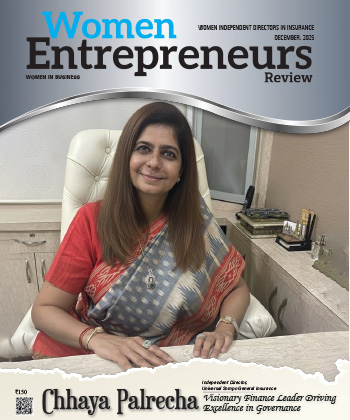
Women in Tech Leadership: Driving Digital Innovation Through Inclusive Design & Strategy
By: Kopal Sarin Raj, Vice President Information Technology, CIO, GCC Head, Wabtec corporation
Koppal Sarin Raj is a dynamic digital transformation expert with more than 29 years of experience in driving business excellence using technology. She holds expertise in IT strategy, enterprise solutions, and performance-oriented interventions in manufacturing, telecom, and engineering. ERP, CRM, and MIS implementation expertise, and a keenness to align systems, processes, and people to deliver quantifiable business value.
In an engaging interaction with Women Entrepreneurs Review Magazine, Koppal shares her views on how organizations are restructuring digital transformation for business resilience, synchronizing IT strategies with changing behaviors, and infusing inclusive design to inform enterprise-wide cultural change.
In today’s volatile tech-investment climate, how are organizations reframing digital transformations to drive tangible business resilience across value chains and operating models?
In the highly volatile world of tech investment today, organizations are no longer thinking of digital transformation as just a cost-cutting measure. Rather, it's now turning into a crucial business-resilience strategy. Although there is a great strategy over new technologies, the actual emphasis is on how digital initiatives can provide quantifiable business value.
Firms are adhering to core principles that guarantee every tech investment enhances efficacy, boosts delivery of services, maximizes costs or revenues, or enhances risk management. All initiatives should relate directly to major business KPIs.
To contain risk and validate viability, companies are implementing a "pilot-first" strategy with new and disruptive technology. This enables teams to investigate real-world problems, confirm findings, and determine scalability prior to broad-based rollout.
By focusing on outcomes and discipline, companies are translating innovation into tangible effects changing their operating models and enhancing value chains in a sustainable, pragmatic manner.
As enterprises migrate from digitization to intelligent automation, how should leaders recalibrate the IT strategy roadmap to align with invisible shifts in customer behavior and industry convergence?
As organizations transition from simple digitization to intelligent automation, IT strategies need to aim towards facilitating rapid, data-informed decisions throughout the business. While external data is readily available, the challenge lies in providing the same degree of access to internal stakeholders.
Leaders must ensure that key information is transparent, timely, and accessible to the right individuals—employees, customers, suppliers, or partners—while still having tight control over who gets to see what. The aim is to enable everyone to respond fast and efficiently when it counts.
This involves examining both mature technologies and new startup solutions that can make enterprise data more intuitive and actionable. Where data is accessible and actionable throughout the value chain, responsiveness is enhanced, collaboration is made stronger, and smarter automation is enabled.
Ultimately, an IT roadmap must prioritize democratizing information. This helps organizations stay aligned with shifting customer expectations and rapid industry convergence.
As technology shapes workplace culture, how can digital leaders use inclusive design to drive company-wide mindset shifts?
Technology is increasingly influencing organizational culture, and digital leaders must have a pivotal role in infusing inclusive design thinking into core systems. We ensure all solutions are available across the organization, on the shop floor and in corporate offices. This ensures that very employee can interact effectively with digital tools.
One of the major emphases is constructing accessibility standards into our software development and procurement processes. This especially benefits people with visual impairment and other limitations. By requiring these specifications from the very beginning, not only do we catalyze inclusive adoption, but also create enterprise-wide cultural shift towards empathy, equity, and universal access in digital transformation.
In multi-domain transformation environments, how do you balance agility with control while designing integrated ERP-CRM architectures that evolve with business priorities?
In intricate transformational environments such as manufacturing and telecom, enabling agility with control in ERP-CRM designs involves a strategic balance of process design and governance. It starts with integrating risk management framework and authority delegation into the system architecture—specifying what can be done and where governance is required.
Rather than automating suboptimal or even manually intensive processes, optimizing workflows are the focus through exception-based management and enlightened alerts. This reduces blockage and eliminates unnecessary approvals, thus improving agility without sacrificing control. By only allowing deviations to initiate intervention, systems can run smoothly while being in compliance.
How should mentoring approaches evolve for women leaders in digital transformation, particularly in legacy industries?
Mentoring styles for women leaders in digital transformation, especially in legacy sectors, need to equip them with the confidence to lead the way and address high-priority business issues. It's not about being different with legacy industries, but about challenging women to contribute bold, well-informed ideas.
Mentors should coach them to incorporate outside input, champion creative thinking, and position themselves as authoritative, trusted voices in digital transformation. This works influence and builds leadership presence. Ultimately, good mentoring should be able to empower women to own and lead successful technology-driven initiatives by harmonizing their efforts with strategic business results.
Most Viewed
- 1 Women's Health Startup HerMD Closing Doors Amid Industry Challenges
- 2 5 Famous Women in Indian Armed Forces
- 3 Saudi Women No longer Require Male Permission for Clothing Choices, says Prince MbS
- 4 Kolkata Medtech Startup Innovodigm Raises Rs 5.5 Crore Seed Funding Led by IAN Group
- 5 Yamunanagar's Kashish Kalra Honoured after Securing 111th Rank in UPSC Civil Services Exam
- 6 Madurai Appoints Its First Woman Corporation Head
- 7 IAS Vijayalakshmi Bidari Appointed as the new Nagpur Divisional Commissioner
- 8 American Entrepreneur Lucy Guo Overtakes T Swift to become Youngest Female Billionaire
- 9 ICC Women's World Cup 2025 Trophy Showcased at Indore's Holkar Stadium
- 10 Aparna Saxena's Beauty Venture AntiNorm Launches in India
- 11 Vidya Nataraj Co-Founded BlueStone Jewellery & Lifestyle files IPO
- 12 5 Women Freedom Fighters of India
- 13 Dr. G Krishnapriya appointed as CEO for Trichy
- 14 M3M & Sirona Partner to Introduce Menstrual Hygiene Vending Machines in 15 Locations
- 15 Punjab Govt launches SHE Cohort 3.0 Supporting Tech-led Women Startups
- 16 Indian origin Lawyer, Sweena Pannu appointed as the US New Superior Court Judge
- 17 The Aurora Tech Award recognizes 4 Indian Women-led Startups
- 18 Kerala's Republic Day parade featured an all-female tableau
- 19 Manisha Kabbur Becomes Karnataka's First Woman International Karate Coach
- 20 Director K. S. Ravikumar's Daughter Maalica Ravikumar Launches Life Coaching Company 'Evergrowth Academy' for Women
- 21 Leezu's Raises Pre-Seed Funding to Accelerate Growth in Sexual Wellness Industry
- 22 Sattu: Super-easy summer drink for PCOS gut healing
- 23 Swathi Nelabhatla creates Sitha App, India's First Women-Exclusive Gig Platform
- 24 7 Timeless Female Kathak Dancers & their Iconic Legacies
- 25 Meet 7 Iconic Women Architects of Modern India & their Most Impactful Work
- 26 This Woman-led Insuretech Startup is Helping Bridge the Education Financing Gap in India
- 27 Women Leaders Share Lessons Learnt from India Women's WC Win
- 28 5 Enterprising Women Founders Powering Singapore's Tech & Innovation Landscape
- 29 4 Women. 4 Stories. One Vision for Smarter, Stronger Healthcare
- 30 Global Gender Gap Narrows to 68.8%, But Full Equality 123 Years Away: WEF Report 2025
- 31 Changemakers: 7 Women Entrepreneurs Taking the Make in India Movement Forward
- 32 Meet Lucy Guo, The Youngest Self-Made Female Billionaire Disrupting Tech
- 33 How Women are Driving India's Festive Online Shopping Surge






